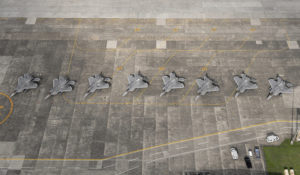
You can’t make this up. As Hurricane Michael ripped through the Florida panhandle, home to Tyndall Air Force Base, an unspecified number of F-22s were damaged because they lack the parts to be operational and were stuck in hangars to take a beating, reports the WSJ:
Part of the F-22 problem is upkeep on a coating that helps the planes evade radar. Another issue is the supply chain for parts now that the U.S. no longer produces the airplane, and “some original manufacturers no longer make the parts or are completely out of business,” GAO notes. Air Force officials told GAO that a simple wiring harness requires a 30-week lead time for finding a new contractor and producing the part. Ripping out parts from planes that work, or “cannibalizing,” is now common practice in military aviation.
As I wrote to you last week the F-35 is a terrible replacement:
It was a mistake cancelling the twin engine F-22 program. The funds had been sunk so to speak. And then it was cancelled in the ninth inning. Talk to any pilot and he’ll tell you two engines are better than one.
Now, the inferior single-engine F-35 is grounded because of another problem with its balky engine. Not good if you have only one of them.
The F-35 program has never really gotten off the ground. It’s been pushed. It’s been forced. Here’s a thought. If Jeff Bezos has figured out a way to sell rockets to the Air Force, let’s open the F-35 engine to real market competition. It would be a great way forward for the F-35 instead of the politicized process we have now. The WSJ reports:
The Pentagon on Thursday said much of the global fleet of Lockheed Martin Corp. F-35 combat jets was temporarily grounded to investigate engine problems that may have caused a Marine Corps plane crash last month.
Officials said the fleet of about 320 jets would undergo inspections over the next 48 hours to check fuel tubes in engines that are made by Pratt & Whitney, a unit of United Technologies Corp.
The suspect tubes may be installed on around half of the global fleet, limited to planes made before 2016, according to people familiar with the F-35’s production process. Some aircraft have already been inspected and have resumed flying.
“If suspect fuel tubes are installed, the part will be removed and replaced,” said the F-35 Joint Program Office, which oversees the purchase and operation of the planes.
The Pentagon in recent months has said parts shortages and a backlog of maintenance work have left almost half of the U.S. fleet of F-35 unable to fly on any given day. However, there is sufficient inventory of the fuel pipes and production capacity to boost stocks, according to people familiar with the situation.
Read more here.



